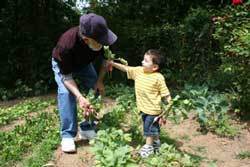
Kids (of all ages) love to play in the dirt. That makes an activity like gardening naturally appealing to young children. It provides them with exercise, helps grow their self-esteem, and gives them an outlet for creativity. Most importantly, it offers them a chance to connect with nature and develop an appreciation for the environment they live in. If you want to plant the gardening seeds in the children in your life, follow these simple guidelines.
Children, especially very young children, have extremely short attention spans. Keep the session short (10-15 minutes), the directions easy ("cover the seeds with dirt") and the tasks manageable ("pat down the soil"). This will leave children with a sense of accomplishment when they are done, instead of feelings of discouragement or frustration. Design activities for both immediate gratification (picking and arranging flowers) and delayed gratification (planting seeds).
Everything involving gardening (the dirt, the bugs, the plants, the tools) has the potential to sidetrack a young child. If you only have a limited amount of time to catch up on some gardening chores before rushing off to a meeting or appointment, leave gardening with small children for another day. Chasing after bugs and digging in the dirt takes time. Rather than feeling rushed, invite children into the garden when you have time to encourage their need for exploration.
If possible, set aside a tiny plot for each child you invite into the garden. Not only does having their "own garden" give them a sense of pride and ownership, it gives them something to nurture and be responsible for. Giving them their own space will also keep them from damaging other more delicate parts of the garden by giving them a place to dig to their heart's content. If your garden space is at a premium, let children grow things in pots. Kids love things that are personalized. Let them insert plant markers with their names and artwork in their plots or pots so they can show others their garden.
Many seed companies now offer fun, brightly colored seed packets just for kids. Plan ahead for success by helping children plant vegetables and flowers that are easy to germinate and exciting to watch grow (e.g. radishes and sunflowers). Children should also have access to tools designed with their size and safety in mind. Most basic tools rakes, shovels, trowels) are available in lightweight durable sizes for children. Empty plastic food containers and mismatched flatware also make good gardening tools for digging and carrying.
In addition to having the right size tools, kids need to know the basics of using them safely. Make sure they know that tools with tines (like rakes) lie face down. Show them how to properly care for their tools, and designate a special space for them in the garage or shed to store them to store their tools.
Children are swept up by their imagination. Planting gardens around a theme will excite their senses and encourage their creativity. Plant a "Giants Garden" full of tall sunflowers, long beans and over-sized melons, or maybe a "Pizza Garden" with oregano, tomato and basil. Plant a red garden using red radishes, red peppers, red carrots and red snapdragons, or a scented garden with mint, lemon grass and chives.
Young children love to do whatever adults are doing. If you show enthusiasm for something, they will follow suit. Work side by side with them in the garden when completing tasks like pulling weeds. Let them look through seed catalogs with you and discuss which flowers or plants they find attractive or interesting. Bring gardening into indoor activities like watching a caterpillar turn into a buttery fly, making mosaics out of old seeds, constructing fairy houses or baking muffins using vegetables from the garden.
Take trips to the library together to look for books on gardening topics like flowers or bugs or surf the Internet for gardening websites aimed at children. Organic gardening offers more opportunities for learning and provides children with an environment free of toxic chemicals.
If you're separated from the children in your life by distance, there are still ways you can garden together. Today's technology makes it easy to share gardening experiences across the miles. If you have access to a computer, consider investing in a digital camera or setting up an inexpensive web camera to share gardening pictures and progress. Share seeds and growing instructions in the mail, visit arboretums or botanical gardens when you're together or send pictures of trees you've planted in honor of the important milestones in each child's life.

About The Author: Ellen Brown is our Green Living and Gardening Expert. Click here to ask Ellen a question! Ellen Brown is an environmental writer and photographer and the owner of Sustainable Media, an environmental media company that specializes in helping businesses and organizations promote eco-friendly products and services. Contact her on the web at http://www.sustainable-media.com
Add your voice! Click below to comment. ThriftyFun is powered by your wisdom!